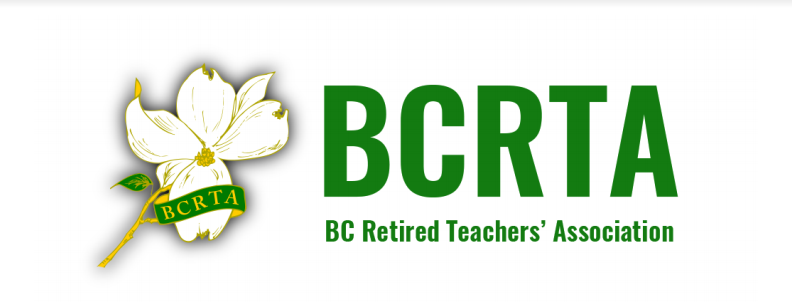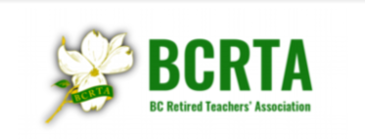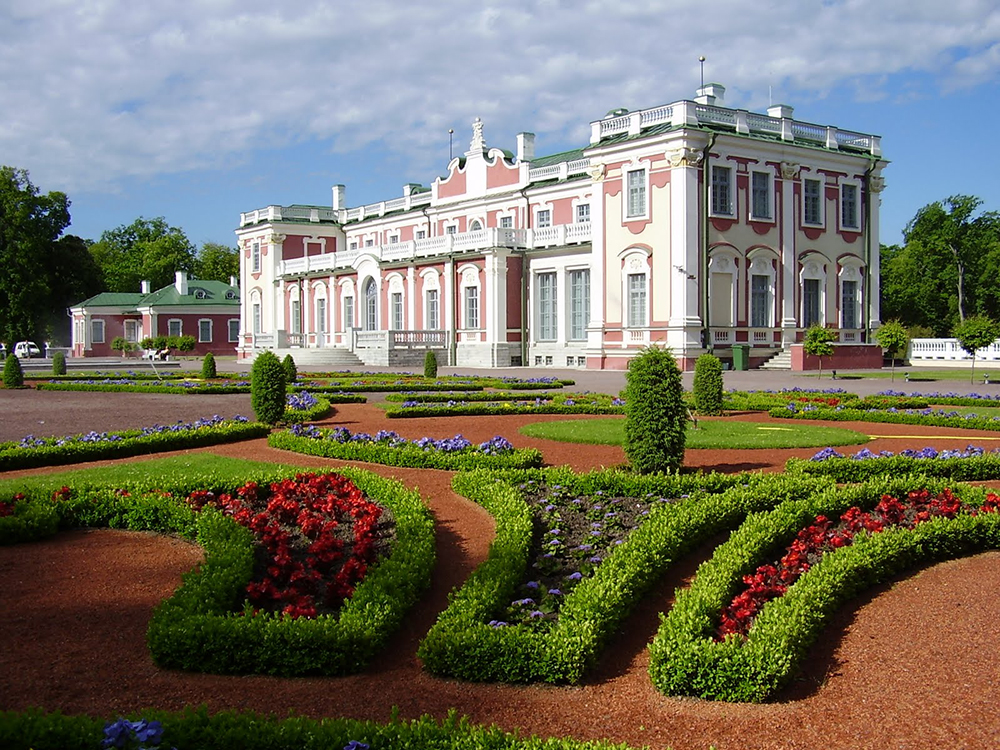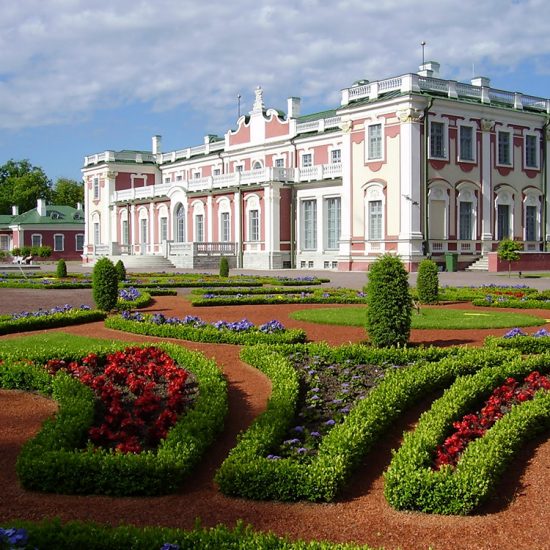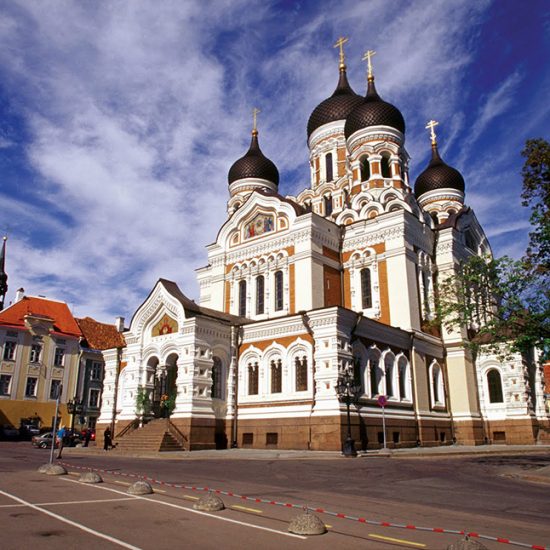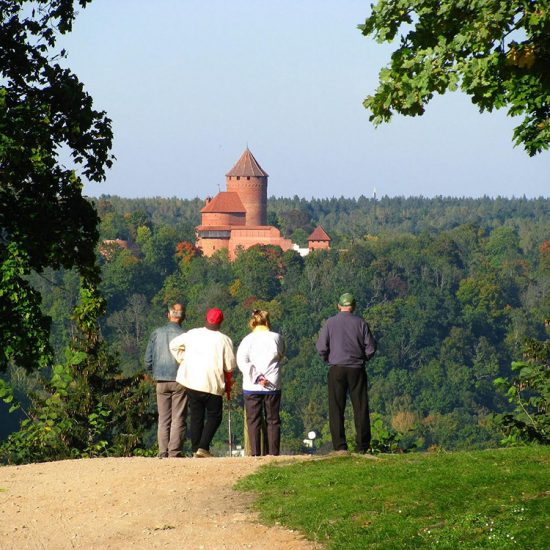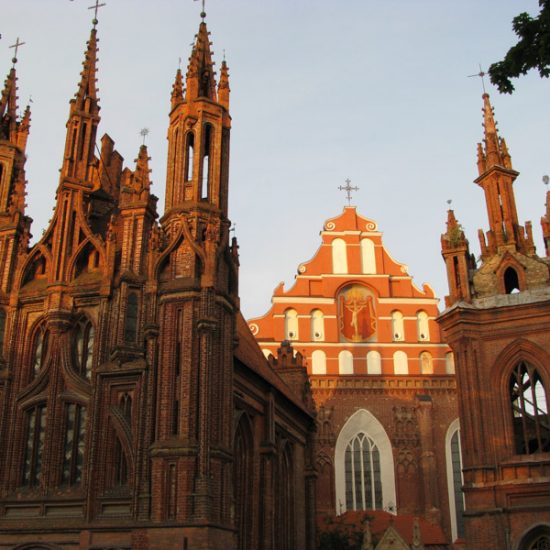1
Join trip in Tallinn (Estonia)
Our trip starts in Estonia's enchanting capital of Tallinn. After checking in to our hotel and meeting the rest of the group, there may be time to explore some of the city at our leisure. With just half a million citizens, Tallinn is not a sprawling metropolis.
This adds to its charm, as it is easy to explore on foot, with minimal traffic. Famed for its medieval architecture, the Old Town is one of the best preserved Hanseatic town centres in the world and a UNESCO World Heritage Site. The city also boasts a vibrant cafe, restaurant and nightlife culture, which you may choose to experience this evening.
The majority of visitors to the Baltic States will be surprised by the quality, variety and value of food and drink on offer. The majority of food is locally sourced and part of the regions heritage is being able to forage for food and make local brews.
Walking through the forests you will see locals passing the time picking mushrooms and gathering berries. There are a lot of traditional restaurants, with influences from Germany and Russia, serving locally produced dishes. There's a wide variety on the menu including soups, casseroles, salads, meat and fish dishes.
Beer is locally brewed and you can find light and dark beers, filtered or unfiltered all for a reasonable price. You can also find flavoured wines such as raspberry and cherry wine and each country has its own herbal liquor which is a popular after dinner tipple.
Accommodation: Hotel Go Schnelli (or similar)
Meals Provided: None
2
Morning walking tour of Tallinn with a free afternoon
Only 57 miles across the water from Helsinki and midway between St Petersburg and Stockholm, Tallinn has come under several different cultural influences since the first stronghold was built in the 10th century. Linguistically and economically, Estonia's closest ties are to Finland, despite the best efforts of other nations.
In 1561, as a coveted trading port, it was seized by the Swedes and held for 150 years until the Russians took over and industrialised much of the medieval town. Perched on a hill overlooking the sea, we'll explore the cobbled Old Town on foot this morning.
The colourful houses of the crooked streets reflect the German, Scandinavian and Russian periods of Tallinn's history. We'll walk through the quarter where merchants once traded and take in the historical and architectural highlights. The busy town square is a hectic mix of pavement cafes and shops, dominated by the 14th century gothic Town Hall. The pink Parliament buildings and Toompea Castle lie near the imposing deep yellow Alexander Nevsky Cathedral, which is topped with 11 bells.
This afternoon has been left free for you to explore further at your own pace. Estonia is well known for its traditional handicrafts. Keen shoppers might enjoy browsing for knitted mittens and lacy woollen shawls, along with colourful hand embroidered linen products.
Accommodation: Hotel Go Schnelli (or similar)
Meals Provided: Breakfast
3
Tour of Saaremaa Island including Kaali Meteorite Crater
Today we drive towards the Gulf of Riga, heading for the largest of the offshore islands, Saaremaa, reached by a short ferry ride from the mainland. The island remained isolated during the years of Soviet domination as it was a strategic military outpost and was perceived to be a possible escape route to the west.
It therefore retains its own culture, traditions and simple way of life. En route, we'll break our journey on Muhu Island, where you will have the option to visit Koguva Museum - a fascinating ethnographical open air museum, providing a great insight into the old way of life. Once we arrive on Saaremaa we will stop at the Karja Church, with its rich medieval stone sculptured decoration, as well as the photogenic wooden Angla Windmills.
Lastly we view the 4000-year old Kaali Crater - created by a meteorite with an impact comparable to the Hiroshima bomb, incinerating forests around it. Later this afternoon we arrive in Kuressaare and check-in to our hotel.
Accommodation: Staadioni Hotel(or similar)
Meals Provided: Breakfast
4
Explore Kuressare including Saint Laurentius Church
Highly regarded by Estonians for its reputation as a crime free society, Saaremaa naturally attracts many summer visitors from the mainland.
We plan to spend the day on this relaxed and fertile island, where long-standing windmills, solid churches and juniper groves provide an appealing landscape. Kuressare is the main town, with a fine 14th century castle and picturesque centre. During our time on the island, we'll visit the Town Hall and St Laurentius Church.
In your free time, you have the option to visit Bishop's Palace - one of the best preserved medieval castles in Europe.
Accommodation: Staadioni Hotel (or similar)
Meals Provided: Breakfast
5
Travelling to Tartu, the oldest town in Estonia
Today we take a short ferry ride to Tartu, the oldest town in Estonia and the country's second city.
On the way, we will stop at the old town of Parnu for a lunch break and a chance to stretch our legs.
Our free evening in Tartu allows us to explore this vibrant and leafy university city.
Accommodation: Tartu Hotel (or similar)
Meals Provided: Breakfast
6
Morning walking tour of Tartu including Toomemagi Hill
A walking tour allows us to explore the 18th century classical architecture of this cultural city, including the town square of Raekoja Plats, with its now famous 'kissing students' statue.
We'll also visit Toomemagi Cathedral Hill, an Estonian stronghold in the 5th and 6th centuries and now the site of several university buildings alongside a beautiful park.
Later you will have some free time to explore further. You may choose to return to Raekoja Plats, with its many shops and restaurants.
Accommodation: Tartu Hotel (or similar)
Meals Provided: Breakfast
7
See Cesis and Sigulda en route to Riga (Latvia)
On our journey into Latvia, we pass through an area which has many protestant links - one of the legacies of its German connections from the days of the Crusaders.
On their return from the 13th century Holy Wars in North Africa, the Knights of the Sword were sent to convert the pagan Baltic people. Northwest Latvia provides some of the most attractive scenery in the country. This area is rich in archaeological sites, agricultural land and tranquil villages, dotted with rivers, forests and lakes.
We will stop off at Cesis in the Gauja National Park where you have the chance to visit the ruins of the 13th century Order of Knight's Castle, as well as the soaring gothic tower of the 13th century Church of St. John.
We will also have the opportunity to take in the evocative ruins of Sigulda Castle, once a formidable knight's stronghold. Before arriving in the capital, Riga, our base for the next two nights we visit Turaida Castle.
The medieval castle is on the opposite bank of the Gauja River from Sigulda and the red brick structure is an imposing sight amidst the trees.
Accommodation: Hanza Hotel (or similar)
Meals Provided: Breakfast
8
Walking tour of Riga's historic old town
Although one-third of Latvia's population live in Riga, most of the important sites are concentrated in a small area and so a walking tour is the most effective way to explore. The old Hanseatic city on the banks of the Daugava River is arguably the most beautiful in the Baltics.
Its skyline is pierced with spires, towers and weather vanes, making the streets a joy to amble through. We will take in the Freedom Monument, Gunpowder Tower, St. Jacob's Church and the city's cathedral.
Buildings have been painstakingly restored over the last twenty years and solemn gothic buildings are juxtaposed with baroque architecture. Art nouveau from the turn of the century reflects that period's affluence, with decorative architecture making every corner a delight.
Riga also has a lively market, which sells traditional produce, such as smoked fish, sauerkraut, pickled garlic and crusty cheeses.
Accommodation: Hanza Hotel (or similar)
Meals Provided: Breakfast
9
Free day in Riga or the chance to visit Jurmala
Today has been left free for you to enjoy Riga at your own pace. You may choose to relax and enjoy a long lunch at one of the many restaurants. Latvian cooking, as in other Baltic states, is wholesome, making use of the abundant dairy products, such as sour cream and yoghurt.
Caraway seeds are often used, but otherwise food is hardly spiced. Cheese and meat filled pastries served with wild berry preserves are popular, especially when washed down with the local beer, which is sold from the tanker to the jar, bucket or bottle! Later in the day, we suggest a drink at one of Riga's lively street cafes.
Alternatively, you may decide to visit Jurmala - a series of coastal villages with long sandy beaches and pretty cottages. The fascinating ethnographic museum of wooden architecture is also worth a visit.
Accommodation: Hanza Hotel (or similar)
Meals Provided: Breakfast
10
Rundale Palace and the Hill of Crosses en route to Klaipeda (Lithuania)
Heading south, we'll visit Rundale Palace, built in the 18th century by Anna, Empress of Russia, for her lover, Count Biron, later Duke of Courland. The architect, Bartholomeo Rastrelli, also built the Hermitage in St Petersburg. The 138 room palace is richly decorated with some fine paintings and exquisite furniture and represents a classic example of the fusion of German and Russian society.
The over ambitious Duke had to wait more than two decades to see the completion of the palace, as he was banished to Siberia on the Empress' death. We then cross into Lithuania, the largest of the three republics and distinguishable from its neighbours by its Catholicism, which acted as the mainstay of Lithuanian nationalism.
Although Lithuania converted to Christianity almost 200 years later than its northern neighbours, the Church retained its power and today most people are devoutly religious. On our travels, we are likely to see many wooden shrines and lavish churches.
We visit the 'Hill of Crosses' near Siauliai where a vast number of rosaries and crosses adorn a small hill. In more modern times, German and Soviet troops tried to crush this symbol of national and religious fervour, but images of the Virgin and literally thousands of crosses always reappeared.
We continue to Klaipeda, a major port and the third largest city in Lithuania, where we will spend the night.
Accommodation: Amberton Klaipeda (or similar)
Meals Provided: Breakfast
11
Visit Curonian Spit National Park with time on the beach
We spend the morning exploring the area around Curonian Spit National Park, where the forests are inhabited by moose, wild boar and many bird species.
We visit the wooden sculptures at the 'Hill of Witches' and the little fishing town of Nida, situated on drifting sand dunes. Its constant movement has meant that the community has had to move with nature over the centuries.
Walking along the beaches, you may be lucky enough to find a piece of amber, especially after a storm.
Depending on the weather, we can either spend more time at the beach or drive back to Klaipeda to explore more of the city.
Accommodation: Amberton Klaipeda (or similar)
Meals Provided: Breakfast
12
Walking tour of Kaunas including the castle ruins
Today we journey to Kaunas - the country's temporary capital between 1920 and 1939 when Vilnius was forcibly annexed by the Poles. Situated in the heart of Lithuania, it is often regarded as the most typical city in the country.
Many of its buildings date back to the 17th century, when the Jesuits bought tracts of land here and built a large monastery. Some buildings are older, with impressive examples of gothic architecture.
After a tour of the town, the rest of the day will be free to relax and enjoy our surroundings.
Accommodation: Best Western Santaka (or similar)
Meals Provided: Breakfast
13
Vilnius via Pazaislis Monastery and Trakai Castle
Our drive to the capital of Vilnius takes us via Pazaislis Monastery, the largest monastic complex in the country and a fine example of baroque architecture.
We will also visit Trakai, the former capital of the Grand Duchy of Lithuania. Set on an island in a lake, the splendid red brick castle dates back to the 14th century.
The castle houses some interesting museums, including an exhibition on pre-war Lithuania.
After checking in to our accommodation in Vilnius, the rest of the evening is free to start exploring the city.
Accommodation: Panorama Hotel (or similar)
Meals Provided: Breakfast
14
Tour of Vilnius including the Chapel of the Dawn
The Catholic influence on Vilnius is very evident from the numerous baroque churches. By the turn of the last century, Vilnius also had an 80,000-strong Jewish community. However, by the end of World War II it was completely decimated.
During our morning sightseeing of the capital, we visit the ancient university founded by the Jesuits - a centre of the Counter Reformation and a source of Lithuanian culture.
- We will also see the cathedral and the Chapel of the Dawn, which is home to the Black Madonna. In the newer part of Vilnius lies the main shopping street with the opera, cafes and parliament building.
- This afternoon has been left free to explore at your own pace.
Accommodation: Panorama Hotel (or similar)
Meals Provided: Breakfast
Our trip ends in Vilnius this morning, after breakfast.
Meals Provided: Breakfast
Call for assistance: 1-800-481-9739 ext. 1
Mention Promo Code for Savings: TRIPMERCH100

